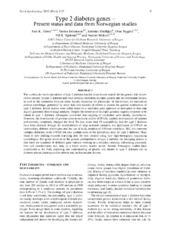| dc.contributor.author | Hertel, Jens Kristoffer | en_US |
| dc.contributor.author | Johansson, Stefan | en_US |
| dc.contributor.author | Midthjell, Kristian | en_US |
| dc.contributor.author | Nygård, Ottar | en_US |
| dc.contributor.author | Njølstad, Pål Rasmus | en_US |
| dc.contributor.author | Molven, Anders | en_US |
| dc.date.accessioned | 2018-04-26T12:52:27Z | |
| dc.date.available | 2018-04-26T12:52:27Z | |
| dc.date.issued | 2013 | |
| dc.Published | Hertel J, Johansson S, Midthjell K, Nygård O, Njølstad PR, Molven A. Type 2 diabetes genes : present status and data from Norwegian studies. Norsk Epidemiologi. 2013;23(1):9-22 | eng |
| dc.identifier.issn | 0803-2491 | |
| dc.identifier.issn | 1891-5477 | |
| dc.identifier.uri | https://hdl.handle.net/1956/17660 | |
| dc.description.abstract | The worldwide rise in prevalence of type 2 diabetes has led to an intense search for the genetic risk factors of this disease. In type 2 diabetes and other complex disorders, multiple genetic and environmental factors, as well as the interaction between these factors, determine the phenotype. In this review, we summarize present knowledge, generated by more than two decades of efforts to dissect the genetic architecture of type 2 diabetes. Initial studies were either based on a candidate gene approach or attempted to fine-map signals generated from linkage analysis. Despite the detection of multiple genomic regions proposed to be linked to type 2 diabetes, subsequent positional fine-mapping of candidates were mostly inconclusive. However, the introduction of genome-wide association studies (GWAS), applied on thousands of patients and controls, completely changed the field. To date, more than 50 susceptibility loci for type 2 diabetes have been detected through the establishment of large research consortia, the application of GWAS on intermediary diabetes phenotypes and the use of study samples of different ethnicities. Still, the common variants identified in the GWAS era only explain some of the heritability seen for type 2 diabetes. Thus, focus is now shifting towards searching also for rare variants using new high-throughput sequencing technologies. For genes involved in the genetic predisposition to type 2 diabetes the emerging picture is that there are hundreds of different gene variants working in a complex interplay influencing pancreatic beta cell function/mass and, only to a lesser extent, insulin action. Several Norwegian studies have contributed to the field, extending our understanding of genetic risk factors in type 2 diabetes and in diabetes-related phenotypes like obesity and cardiovascular disease. | en_US |
| dc.language.iso | eng | eng |
| dc.publisher | Norsk forening for epidemiologi | eng |
| dc.rights | Attribution CC BY | eng |
| dc.rights.uri | http://creativecommons.org/licenses/by/4.0 | eng |
| dc.title | Type 2 diabetes genes : present status and data from Norwegian studies | en_US |
| dc.type | Peer reviewed | |
| dc.type | Journal article | |
| dc.date.updated | 2017-12-29T12:25:03Z | |
| dc.description.version | publishedVersion | en_US |
| dc.rights.holder | Copyright 2013 The Author(s) | |
| dc.identifier.doi | https://doi.org/10.5324/nje.v23i1.1597 | |
| dc.identifier.cristin | 1051179 | |
| dc.source.journal | Norsk Epidemiologi | |
| dc.relation.project | Norges forskningsråd: 197064 | |

